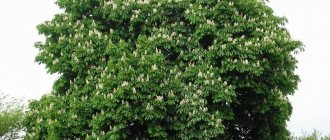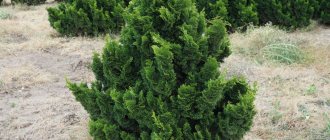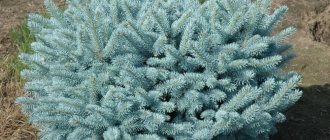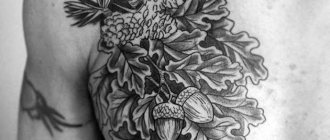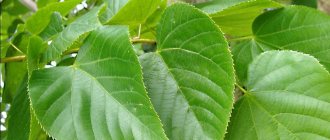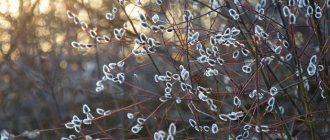Some sources say that his homeland is Europe, while others say Australia. However, there are between 14 and 30 varieties in the world. Most of them can be found in China, Japan, North America and European countries.
Botanical description
Horse chestnut is a plant belonging to the Horse chestnut family. It is a tree with a spreading, dome-shaped crown. It reaches a height of 36 meters. The trunk has a cylindrical shape, a powerful root system, and is covered with dark brown bark.
The leaves of the tree are compound, slightly toothed, located on long petioles. The flowers are white, collected in cone-shaped panicles. The size of the inflorescences is no more than 30 cm. The flowers have inclusions of a yellowish tint.
A peculiarity of chestnut flowers is that the spots on them, after the plant secretes nectar, change color from yellow to red. This is a kind of signal for insects that pollinate the crop.
During the ripening period, fruits appear, which are boxes, the surface of which is equipped with thorns. The color of chestnuts is green, the size is 2-4 cm. Inside the fruit there is a seed, sometimes two. The ripening period begins in August-September.
About suitable soils
It is preferable for chestnut to grow on chernozem or loamy soil, because they retain moisture better and nourish the tree. However, it should be taken into account that the plant still does not tolerate excess water. Therefore, to loamy soil before planting a tree there. Due to the nature of the soil, it may be necessary to build some kind of drainage system to drain excess water.
We advise you to carefully consider all the nuances before decorating your plot with green spaces, and then for many years you will admire the beauty of the majestic chestnut tree with a spreading crown and relax with your family under its shade on hot days.
Chemical composition
It is not for nothing that horse chestnut is famous for its beneficial properties. After all, it contains a large number of valuable components that are necessary for the human body and help maintain good health.
The plant contains tannins, magnesium, iron, zinc, esculin, escin, isoquercetin, fatty oils, starch, coumarins, amino acids, pectin, glycosides, vitamins C, B1
How is horse chestnut different from regular chestnut? How to distinguish between horse chestnut and edible chestnut
Usually, the word chestnut hides two diametrically opposed plants. One of them is horse chestnut, which we already talked about once. This is a beautiful tree, the fruits of which, however, are not eaten. But its namesake, the edible chestnut, as the name implies, has a rather pleasant taste. Why do two such different plants have such similar names and how not to confuse them with each other? We'll tell you in this article.
Horse chestnut - brief description
Horse chestnut is a genus of trees in the Sapindaceae family. The old name of the family is horse-chestnut. It is usually a tall tree or shrub with large palmate leaves forming a lush crown. This plant feels best in a temperate climate. Excellent for urban landscaping, so it is often planted in city parks and gardens.
The fruit is a three-leaf green capsule with small thorns. When it ripens, the capsule opens and reveals a large brown seed, which, by analogy with the whole plant, is called a chestnut. It is not consumed as food, and in some cases it can even cause poisoning.
True chestnut - brief description
True chestnut or edible chestnut, unlike horse chestnut, belongs to the beech family. This plant also prefers warm temperate climates. It grows in large quantities in the Mediterranean region. The leaves of this plant are simple, arranged spirally on the shoot in two rows. The fruits ripen in a brown shell with branched spines. The nuts themselves are brown, round with a pointed tip. They are yellowish-white inside. The taste is quite pleasant. They can be consumed both raw and after heat treatment.
Horse or edible - how to distinguish?
If from the brief description you have not yet understood what the difference is between the plants, we suggest you use our detailed instructions.
- Look at the fruits. If their shell is brown and has many spines, it is an edible chestnut. The horse's shell is green and has sparse spines.
- Take a look at the bloom. Horse chestnut blooms very beautifully. The inflorescences are pyramidal, lush and grow vertically upward. Their appearance somewhat resembles white candles. But the flowers of the edible chestnut are less beautiful: in appearance they look like long narrow earrings.
- Take a look at the leaves. If they have a simple elongated shape and jagged edges, then this means that this is an edible plant. Horse chestnut has more decorative leaves, consisting of 5 or 7 parts, collected in a fan. With the onset of autumn, they acquire a rich yellow color.
- Taste it. If there are no trees in front of you, but only fruits, you can tell them apart by taste. Don't worry, eating a small amount of horse chestnut will not cause any negative effects. But if you feel the characteristic bitterness, know that this is it. Edible chestnut has a sweet taste.
Conclusion
Well, now you can't be fooled. You can always distinguish these two plants, even if you only have fruits in front of your eyes. This will save you not only when purchasing seedlings, but even if you want to stock up on nuts for eating.
The healing effects of chestnut
Medicinal properties of horse chestnut:
- Eliminates tissue swelling.
- Suppresses the inflammatory process.
- Reduces blood clotting.
- Reduces blood viscosity, prevents the formation of blood clots.
- Strengthens vascular walls, making them less permeable.
- Normalizes stomach acidity levels.
- Relieves tissue spasms.
- Normalizes the functioning of the gallbladder.
- Reduces pain.
- Stabilizes the functioning of the liver and heart.
- Increases vein tone.
- Improves blood circulation in the body.
- Lowers blood pressure.
- Dilates blood vessels.
- Normalizes blood cholesterol levels.
- Restores the digestive process.
Chestnut removes harmful substances from the body.
Such a huge range of beneficial properties of chestnut allows the plant to be actively used for medicinal purposes.
Indications for use
Horse chestnut is used in the treatment of the following diseases:
- Phlebeurysm. The pathology is characterized by thinning of the walls of blood vessels and the formation of venous nodes. The plant helps strengthen vascular tissue, promotes the resorption of nodes, and prevents the formation of blood clots.
- Pathologies of the respiratory organs. Chestnut-based infusions and decoctions are prepared for washing the nasal passages and gargling. The products have a good antiseptic and anti-inflammatory effect, accelerating recovery.
- Diseases of the digestive organs. Horse chestnut helps in the treatment of gastritis, peptic ulcers, and inflammation of the gastrointestinal mucosa.
- Disturbances in the functioning of the cardiovascular system. The plant fights atherosclerosis, high cholesterol levels in the blood, eliminates swelling, and promotes the resorption of blood clots.
- Joint and muscle pathologies. Chestnut-based products relieve spasms, reduce pain, and suppress inflammation. All this helps in the treatment of arthritis, rheumatism, and neuralgia.
- Uterine bleeding in women. The plant has a hemostatic effect.
- Inflammation of the genital organs in women. The herb helps suppress inflammatory processes in the uterus and ovaries.
Prostatitis, varicocele in men. Chestnut-based products reduce inflammation, improve blood circulation, and relieve pain
Before using the plant, you should consult a specialist.
Contraindications and adverse reactions
It is prohibited to use horse chestnut folk remedies in the following cases:
- Acute kidney or heart failure.
- Increased blood clotting.
- Individual intolerance.
- Tendency to an allergic reaction.
- Chronic constipation.
- Childhood.
- Carrying a baby.
- Breast-feeding.
When using the plant, the recommended dosages should be strictly followed. Otherwise, side effects may occur, for example, vomiting, nausea, abdominal pain, heartburn.
Chestnut-based pharmaceutical products
In the pharmacy you can find a liquid horse chestnut extract called “Aescusan”. In addition to this plant, it also contains thiamine.
Properties of the drug:
- tones veins;
- has an antioxidant effect;
- reduces inflammation;
- strengthens vascular walls.
Aescusan
The drug is most often prescribed for problems with veins. Take a long course of up to 3 months. The drug is also used to treat hemorrhoids, cramps, eliminate muscle pain, swelling, and vascular network. For people with thrombophlebitis, the extract will help heal ulcers.
Pharmacies also sell rectal suppositories based on horse chestnut. They are used in the treatment of hemorrhoids and anal fissures.
Where do they grow?
The edible variety grows on the North American Atlantic coast, Western European and Mediterranean countries, the Caucasus and the Far East. The natural habitat is mountain slopes, where there is fertile soil with moderate moisture.
Noble chestnuts grow mainly in the territories called the Old World - in all fairly warm European countries (France, Spain, Italy and other countries). In Russia, edible chestnut grows only in Kuban.
Home remedies from chestnut
In folk medicine, the following remedies are prepared from horse chestnut.
Tincture
Grind 10 g of flowers or peeled fruits, pour in 100 ml of vodka, let the product brew for 7 days in a dark place. The infusion must be shaken daily. Then strain the medicine and take 30 drops 3 times a day.
The tincture is used to treat hemorrhoids, blood clots, inflammation of the prostate, varicose veins
Water infusion
Pour a teaspoon of crushed bark into 2 cups of cool but boiled water.
Leave the liquid to infuse for 8 hours, strain. Take 2 tablespoons 4 times a day. Used for the treatment of renal pathologies, disorders of the gallbladder, intestines, and also for inflammation in the respiratory system.
Decoction
Take 5 g of flowers and crushed bark, pour 200 ml of boiling water, simmer on low heat for 30 minutes. Then strain and add boiled water to obtain the original volume. Take a tablespoon for the first 2 days, then increase the dose to 3 tablespoons per day.
A decoction is used for inflammatory processes in the veins, hemorrhoids, rheumatism, shortness of breath
Ointment
For external use, an ointment is prepared based on horse chestnut. It helps eliminate tension and fatigue in the legs, suppress inflammation in varicose veins, and relieve tissue swelling.
The product is prepared as follows: pour 5 crushed fruits with 500 ml of vegetable oil, place in a water bath and boil for 60 minutes. Then cool and strain. Apply to affected areas three times daily.
Horse chestnut contains active components that really greatly improve the condition of damaged veins
Oil
Horse chestnut oil can be purchased at a pharmacy or prepared independently at home. To do this you will need to stock up on flowers and fruits. You will also need to prepare grape seed oil for the highest therapeutic effect. If it is not available, any other vegetable oil can be used.
Horse chestnut oil
Cooking method:
- Take 2 tablespoons of crushed raw materials.
- Pour in 10 tablespoons of grape or other oil.
- Let it brew for 2 weeks, then strain.
The resulting product is used externally, rubbed into the skin for varicose veins. It helps strengthen vascular walls, remove venous mesh, relieve leg fatigue, and reduce pain.
Chestnut kvass
You can even make kvass from chestnuts, which also has healing properties. To do this you will need the following:
- Divide 25 fruits into halves.
- Place them in a bag made of gauze, along with a small stone.
- Fill a 2.5 liter jar with chilled boiled water.
- Place a bag of chestnuts there.
- Add a glass of sugar and the same amount of milk-based whey.
- Cover the jar with a gauze layer and place in a dark but warm place so that the drink begins to ferment.
After 14 days, the kvass is completely ready for use. Just strain first. Drink for medicinal purposes 2 glasses per day for one month.
With the help of this drink it will be possible not only to quench your thirst, but also to cleanse the body of harmful substances, restore normal functioning of the digestive tract, and strengthen the immune system.
Application in cosmetology
Horse chestnut is used in the manufacture of cosmetics. For example, you can find the plant in the following products:
- Gel against fatigue, feeling of heaviness in the legs. It can be used daily after a working day, long walking in high heels and in other cases when the lower limbs are very tired.
- Face cream with a rejuvenating effect. The plant helps normalize blood circulation, metabolism in epidermal cells, and also fight free radicals that cause aging.
- Eye cream. With its help you can get rid of dark circles, bags under the eyes, remove small wrinkles, and increase the elasticity of the dermis.
- Ointment to combat rosacea. Chestnut helps reduce redness, strengthen blood vessels, and reduce the visibility of small capillaries.
- Anti-cellulite products. The plant is able to remove excess fluid from the body and normalize lymph flow, which helps eliminate the symptoms of “orange peel.”
Shampoos, hair masks. Chestnut is added to these products to fight dandruff, enhance the growth of curls, and make hair follicles stronger. Cosmetics based on chestnut and other herbs are always preferred by people, as they are the safest.
Spreading
In late spring and the first half of summer, light floral candelabra decorate trees with lush green crowns. Bees are actively working on attractive, fragrant inflorescences. Cross-pollination of the plant by wind is possible. The tree reproduces by fruits (generatively) and shoots (vegetatively).
Interesting: chestnut is a relict plant - it was widely represented on Earth before the Ice Age. Soil studies indicate that chestnut groves existed.
The plant's homeland is considered to be the Mediterranean, East Asia and the Atlantic coast of North America. Loves temperate climates, moist, loose soil. In the mid-16th century, the plant was brought to Europe, but it did not become widespread due to the harsh climate. The selection work of garden servants of wealthy nobles made it possible to expand the growing area.
The “secondary” territory of the representatives of the genus became groves, parks and garden plots around the world. Of the 15 known varieties, 13 grow in Russia at the present stage of evolution. Edible species have settled in the Caucasus and Crimea. Introduced by the Greeks, chestnuts formed unique natural communities with endemics (local plants).
Preparation and storage
All parts of the plant are used for medicinal purposes, since each of them contains enough useful components. The collection of flowers and leaves begins during the flowering period - May-June. The fruits are harvested during ripening, which occurs in the autumn. The twigs and bark of the plant are collected earlier in the spring.
Having prepared the raw material, it is dried. It is recommended to dry leaves and flowers naturally in the open air in a place where direct sunlight does not penetrate. The fruits can also be air dried, but you can also put them in the dryer, especially if the weather outside is damp and cold.
The plant should be stored in a place where moisture does not penetrate. Shelf life – 1 year.
Varieties
Plant varieties are formed due to climatic and geographical conditions. Belonging to a variety is determined, first of all, by the generative part of the plant - the flower.
Horse
Sowing
Asian “brothers” are shorter than European ones. The Chinese have mastered the mountainous terrain, where the soil is rich in calcium compounds. The variety is nicknamed the softest for its obediently drooping branches. It begins to bear fruit earlier than others - from 5-8 years. The nuts of the Japanese representative are the most impressive, reaching a weight of 80 grams.
Can I plant it in the garden?
Horse chestnut can be grown in the garden. There are several ways to plant it.
Horse chestnut in the garden
Using nuts
First of all, it is necessary to prepare the material for planting. It is necessary to collect fruits from the ground, sort them out so that there are no damaged, diseased specimens.
Under no circumstances should you pick them from a tree; it is useless to plant unripe nuts.
After collecting the fruits, you need to peel them, soak them in water, and apply gauze on top. After two days, put them in the refrigerator for 2 weeks, covering them with a layer of moistened river sand. This completes the preparation of the material.
For planting, you should prepare a furrow, the depth of which should not exceed 10 cm. Water it with water with the addition of potassium permanganate. Then start planting, placing the nuts at a distance of 50 cm from each other. Then cover the top with old leaves or sawdust.
It needs to be planted in the fall. With the arrival of spring, remove the top layer from the garden bed so that the sprouts can easily break through
Cuttings
Cuttings should be taken from plants that are more than 5 years old. The optimal time for this is the flowering period. But at the same time, you should not cut branches on which flowers have already bloomed.
Make oblique cuts on the cuttings to form roots. Then treat with growth stimulants. Immediately before planting, let the cut dry, then grease the lower part of the cutting with charcoal to prevent it from rotting.
Next, make furrows, water them with manganese solution, and plant the cuttings in the holes, covering them with soil.
Seedlings
Planting of seedlings is carried out in pre-prepared holes. They need to be dug up first, covered with soil and left for several days so that the soil can settle. It is advisable to do this 2 days before planting the plants.
Next, dig holes so that they are slightly larger than the root system of the crop, water well and plant the seedling, covering it with soil. Then water the planting site again.
Chestnut pruning
Horse chestnut is characterized by slow growth in the first time after planting - for about 10 years. Further growth becomes more active, so there is a need to form a crown, which is done by pruning.
The tree should be pruned for the first time before it actively grows, in order to immediately give it the required shape. Then you will need to cut off the dry branches every spring.
After planting, during the first year, all shoots must be cut in half. In the second year, in spring, remove short branches located on the sides.
After trimming, it is recommended to treat the sections with oil paint 3-4 days after the procedure, when these areas have dried at least a little
Top dressing
Fertilizers must be applied regularly, especially during the first time after planting. But it is important to ensure that there is no excess of nutrients. After replanting the plant, you can add superphosphate, ash, and humus.
In the summer, use complex mineral supplements every month.
Thus, horse chestnut is a medicinal plant used for medicinal purposes, as well as in the manufacture of cosmetics. The fruits of the crop are not eaten.
Fruit
The fruits of chestnuts ripen in early autumn. When they appear, they look like small green snuff boxes with spikes. When ripe, the fluffy snuffbox opens into several parts and throws the nut to the ground. The nut itself is a shell, under which are hidden flattened seeds, dressed in a dark skin. Chestnut nuts of some types are used as food by many peoples. They are eaten fried and baked, and added to confectionery and flour to obtain a higher taste. Inedible fruits are used in medicine or for landscaping, but this has already been mentioned above.
Chestnut wood resembles oak in its strength and appearance. It is used in the furniture industry, plywood production, as well as for other household needs.
